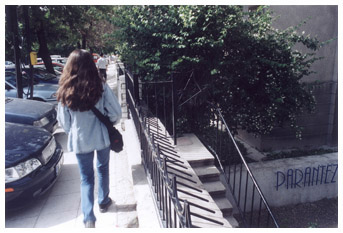


 |


launch interview with Can Altay
An architect, artist, designer, and scholar, Can Altay is interested in unorthodox appropriations of the built environment. Influenced by Georges Bataille's ideas on transgression, Michel Foucault's ideas on power and non-nor-mativity, and Henri Lefebvre's conceptions of social space as well as by art history, Altay approaches his subject matter from a number of discursive directions. His current project, the minibar projections, is an exploration, documentation, and exhibition of the transgressive use of semipublic spaces by young people. Minibars, named by the youth who create and use them, are impromptu gathering places around and in-between buildings in Ankara, the capital city of Turkey. Architectural and geographic "one night stands," they are, in the words of the artist, "a utilisation of physical environment for an event [outside of the intent of] the builders, designers, and residents." These locations become places through occupation, use, and social relations, much as Lefebvre proposed in The Production of Space. Altay's project documents these appropriations in the form of an audiovisual installation--slides, taken at the minibars, are projected in the gallery, along with sound recordings from the events. Viewers are immersed in the experience of the minibars and the space, sometimes casting shadows as they walk through the projected light.
Altay's documentation of informal participants' occupation of the semipublic realm and the resulting architectural and social response (heightened fences, the erection of metal bars) alerts us to the increasing privatization of our surroundings and the almost complete lack of truly public space in the urban sphere. Additionally, his work captures fleeting moments in time, a sense reinforced by the age of the young minibar occupants, who are poised at the edge of adulthood.
Altay was featured in Eve Hediyesi, Oda Projesi, Istanbul, Turkey (2002); Becoming a Place, Proje4L Istanbul Museum of Contemporary Art (2001); and an exhibition at the Çankaya Center for Contemporary Arts in Ankara (2000).
--Aimee Chang











